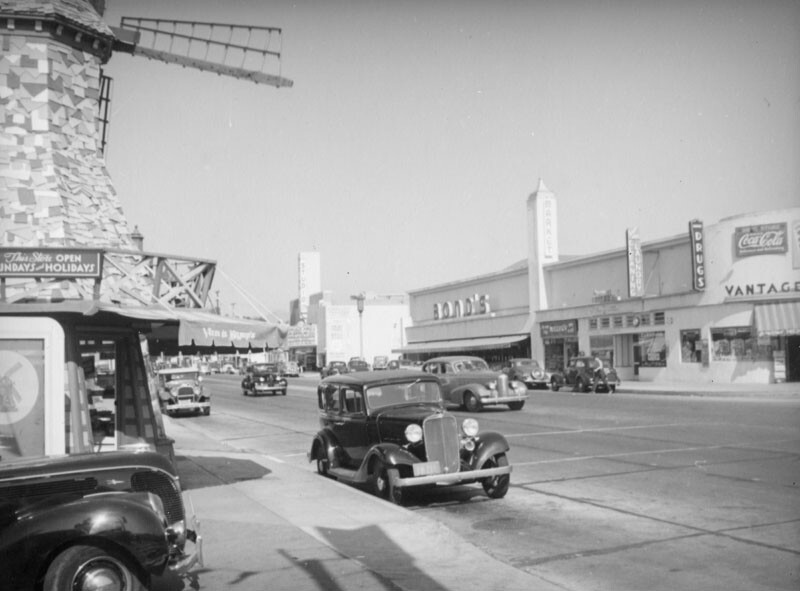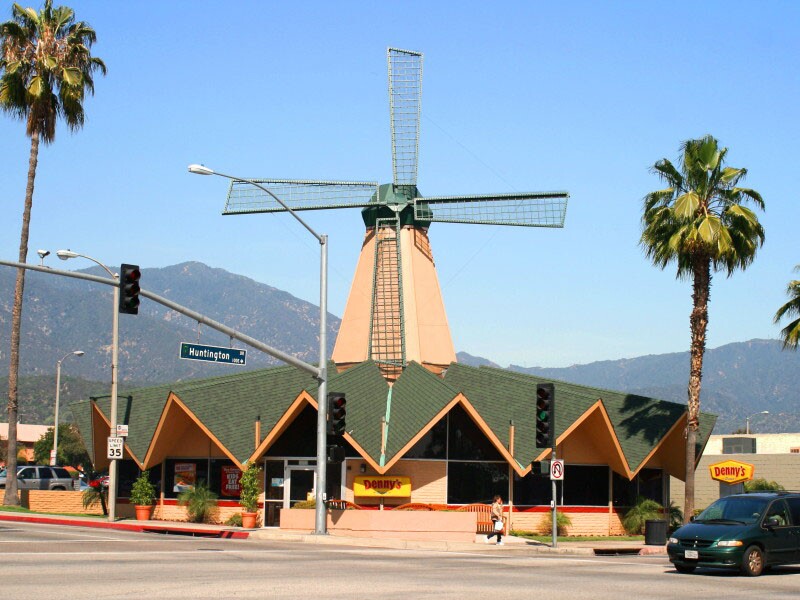Baked Goodness: The Story of Van de Kamp’s Holland Dutch Bakers

Watch the ripple of “please” go ‘round the table whenever Van de Kamp’s cracked wheat rolls are served. Their brown, beckoning crusts are flecked with toasted grains, and thick in every bite, the little wheat nuggets of natural goodness are tender and flavorful as nut meats. Yet these rolls are but one choice out of sixteen kinds of delicious rolls and muffins at your neighborhood Van de Kamp store. And eighteen varieties of well-baked bread. And pies that win the men’s vote every time. And thirty-four varieties of wonderful cakes. As well as doughnuts and pastries, tasty baked beans in family size pots, real Holland Dutch egg noodles, crisp, crunchy pretzels, and golden, oversize potato chips. The wealth of 150 varieties of good things, baked in the old-fashioned Holland Dutch way, is sold in immaculate little neighborhood shops by courteous salesgirls in dainty Holland Dutch costumes. And these foods are guaranteed fresh. They come to your tables bearing that exquisite fleeting fragrance found only on foods fresh from the oven. -Ad in the Los Angeles Times, April 3, 1926
Today, “Van de Kamp’s” generally makes one think of frozen fish sticks, available for sale in your local grocery store. But for older generations of Angelinos, the name conjures up memories of delicious baked goods, swirling windmills, and waitresses dressed in comely “Dutch-style” blue and white costumes. At the company’s height, 320 Van de Kamp’s Holland Dutch Bakers dotted the West Coast. This family business was run out of a handsome Dutch Renaissance Revival factory in the heart of the LA “bread bowl” in Glassell Park.
The Van de Kamp’s origin story is representative of Los Angeles itself. Energetic young people from Milwaukee, of Dutch descent, but thoroughly “American,” coming to the Southland to start anew. In 1938, LA Times columnist Lee Shippey told the story of the company’s early days:
At the ripe age of 22, Theodore Van de Kamp was making reports for insurance companies in his native Milwaukee. His sister Henrietta had married Lawrence Frank, and they had moved to Pasadena. Lawrence had a job as a furniture salesman, which didn’t entirely satisfy him, but Henrietta wrote home that California was swell. Theodore decided he could do insurance reporting in Los Angeles and came out in November, 1914. His sister Marian also came out and the four young people decided they could use extra money. Lawrence’s brother[Ralph] was in the potato chip business, selling to hotels and restaurants. He made good potato chips but didn’t think it possible to retail them. The four young people decided, in secret, to open a potato chip store. Theodore’s grandfather had been a baker in Holland and Theodore always had a lively interest in food. Lawrence was a budding epicure. And all four had a gift for showmanship. “I’ll design Dutch costumes,” said Henrietta. “We’ll sell nothing but genuine Holland Dutch Saratoga chips.”
In January 1915, with an investment of only $200, the Van de Kamp family opened their first food stand in downtown Los Angeles. According to historian Cecilia Rasmussen, “Frank had reasoned that the name would be memorable and its Dutch heritage would connote cleanliness and freshness. They underlined that idea with their motto: ‘Made Clean, Kept Clean, Sold Clean.’” Lee Shippey continues:
They got eight feet frontage at 236 ½ South Spring Street next to the Saddle Rock Café. That was the very heart of Los Angeles then. They did all the work themselves. The place was so small that customers couldn’t enter- they bought at a window as one buys theater tickets. But a bright light shone on the sidewalk, two lovely girls in Dutch costumes scooped up the potato chips which came down a chute, still hot. The fact that Saratoga chips were named for a town in New York and were unknown in Holland didn’t stop the crowd. When Frank had ordered 60 pounds of chips for a starter, his brother had refused to fill the order. He said they were crazy. An hour after that first store opened Frank had to order more.
The chip stand continued to be hugely successful. “We didn’t make them, we bought them[from brother Ralph],” Lawrence Frank remembered with a laugh. “But we had them delivered through a chute in the rear. So people thought they were being fried fresh out back somewhere.” Henrietta and Marian were the first “Dutch girls,” and their personable salesmanship made the stand all the more popular. The family opened four more stands within the year, and opened their first coffee shop at 5th and Spring two years later. They began selling other baked goods, including salted coconut macaroons made by a local female friend. They absorbed a local baker, and began selling white breads. During World War I, war rations led them to invent a whole grain bread that seems decades ahead of its time:
They couldn’t get half enough white flour to fill their needs, so they invented war bread, made of oatmeal, cornmeal, bran and rye. They put a page ad in The Times and taught their girls to chant; “Oatmeal, cornmeal, bran and rye-Sock the Kaiser in the eye.”
After the war, Van de Kamp’s continued to expand. Lawrence and Theodore took the lead in managing the business. "They were a very good team," said Richard N. Frank, son of Lawrence Frank. "My father was the creative one. My uncle was terrific with numbers and did the administrative work. My dad created the products." In 1921, they built a large bakery near Beverly and Western. Outside, they placed a picturesque blue and white windmill, created especially for the company by Hollywood art director Harry Oliver. The windmill would become the company’s trademark. Lawrence Frank, with his gift for creating fantastical spaces, would also open a side business a year later- the legendary Tam O’Shanter.

By 1928, the company boasted 53 bakeries and coffee shops all over Los Angeles. “I knew this area was going to spread,” Lawrence Frank explained. “So instead of concentrating downtown, we opened our places in neighborhoods and surrounding communities.” In 1930, the family built a grand headquarters in Glassell Park. Designed by architect J. Edwin Hopkins, the building was surrounded by other bakeries, including Dolly Madison, Frisco Baking Co., and Foix French Baking. According to Rasmussen:
In June 1931, delivery trucks with the trademark windmill logo began rolling out of the bakery. The blue-and-white boxes inside were filled with chocolate and powdered-sugar doughnuts, chewy macaroons, lemon meringue pies, spongy jellyrolls and heavenly angel food and milk-chocolate cakes.
The company continued to flourish and expand. The family also expanded into the frozen food market. Lawrence Frank continued to open other businesses, and in 1938 he founded the legendary Lawry’s Prime Rib on La Cienega.
Theodore Van de Kamp died in 1956, and the family sold the company to General Bakeries that same year. Van de Kamp’s eventually splintered into two different companies- the bakeries and the frozen foods enterprise. Van de Kamp’s Holland Dutch Bakers filed for bankruptcy in 1990, and the iconic Glassell Park headquarters is now a satellite campus for Los Angeles City College. The frozen foods company lives on. But the dozens of fanciful windmills, that promised that a yummy pastry and a warm cup of coffee were just a car ride away, are long, long gone.



